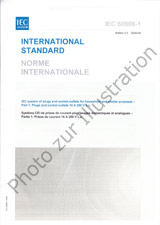Wir benötigen Ihre Einwilligung zur Verwendung der einzelnen Daten, damit Sie unter anderem Informationen zu Ihren Interessen einsehen können. Klicken Sie auf "OK", um Ihre Zustimmung zu erteilen.

IEC 62424-ed.2.0
Representation of process control engineering - Requests in P&I diagrams and data exchange between P&ID tools and PCE-CAE tools
Name übersetzen
NORM herausgegeben am 15.7.2016
Informationen über die Norm:
Bezeichnung normen: IEC 62424-ed.2.0
Ausgabedatum normen: 15.7.2016
SKU: NS-645513
Zahl der Seiten: 344
Gewicht ca.: 1063 g (2.34 Pfund)
Land: Internationale technische Norm
Kategorie: Technische Normen IEC
Kategorie - ähnliche Normen:
Industrial process measurement and controlIT applications in industry
Die Annotation des Normtextes IEC 62424-ed.2.0 :
IEC 62424:2016 specifies how process control engineering requests are represented in a P&ID for automatic transferring data between P&ID and PCE tool and to avoid misinterpretation of graphical P&ID symbols for PCE. It also defines the exchange of process control engineering request relevant data between a process control engineering tool and a P&ID tool by means of a data transfer language (called CAEX). These provisions apply to the export/import applications of such tools. This second edition cancels and replaces the first edition published in 2008. This edition constitutes a technical revision. It is a compatible extension of the first edition. The main changes and extensions are: - updated definitions and new definitions; - identification replaced with reference designation; - updated PCE categories and process functions; - CAEX version 3.0, introduction of: native multiple role support; - nested interfaces; - life cycle meta information; - a separate Attribute library; - updated examples; - updated electronic data model of the PCE request: new normative attribute library for basic PCE request attributes; - new informative extended attribute library for further PCE request attributes; - new informative electronic data model for the PCE request. LIEC 62424:2016 specifie la methode de representation des demandes dingenierie de commande de processus dans un diagramme P&I en vue dun transfert automatique de donnees entre les outils P&ID et PCE, et de maniere a prevenir toute interpretation erronee des symboles P&ID graphiques pour une application PCE. Elle definit egalement lechange de donnees de type demandes dingenierie de commande de processus entre un outil dingenierie de commande de processus et un outil P&ID au moyen dun langage de transfert de donnees (appele CAEX). Ces dispositions sappliquent aux fonctions exportation/importation de ces outils. Cette deuxieme edition annule et remplace la premiere edition parue en 2008. Cette edition constitue une revision technique. Elle est une extension compatible de la premiere edition. Les principales modifications et extensions sont decrites a lAnnexe E et resumees ci-dessous: - mise a jour et ajout de definitions; - remplacement du terme "identification" par "designation de reference"; - mise a jour des categories PCE et des fonctions de traitement; - version CAEX 3.0, introduisant les elements suivants: roles multiples natifs; - interfaces imbriquees; - informations supplementaires sur le cycle de vie; - bibliotheque Attribute separee; - exemples mis a jour; - mise a jour du modele de donnees electroniques de la demande PCE: nouvelle bibliotheque dattributs normative pour les attributs de demande PCE de base; - nouvelle bibliotheque dattributs etendue informative pour les autres attributs de demande PCE; - nouveau modele de donnees electroniques informatif de la demande PCE.
Empfehlungen:
Aktualisierung der technischen Normen
Wollen Sie sich sicher sein, dass Sie nur die gültigen technischen Normen verwenden?
Wir bieten Ihnen eine Lösung, die Ihnen eine Monatsübersicht über die Aktualität der von Ihnen angewandten Normen sicher stellt.
Brauchen Sie mehr Informationen? Sehen Sie sich diese Seite an.



 Cookies
Cookies
